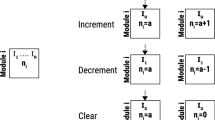Abstract
Spiking neural P systems (SN P systems, for short) are a class of distributed parallel computing devices inspired from the way neurons communicate by means of spikes. In this work, we consider SN P systems with the following restriction: at each step the active neuron with the maximum (or minimum) number of spikes among the neurons that can spike will fire [if there is a tie for the maximum (or minimum) number of spikes stored in the active neurons, only one of the neurons containing the maximum (or minimum) is chosen non-deterministically]. We investigate the computational power of such sequential SN P systems that are used as language generators. We prove that recursively enumerable languages can be characterized as projections of inverse-morphic images of languages generated by such sequential SN P systems. The relationships of the languages generated by these sequential SN P systems with finite and regular languages are also investigated.

















Similar content being viewed by others
References
Chen H, Freund R, Ionescu M, Păun Gh, Pérez-Jiménez MJ (2007) On string languages generated by spikng neural P systems. Fund Inform 75:141–162
Chen H, Ionescu M, Ishdorj T-O, Păun A, Păun Gh, Pérez-Jiménez MJ (2008) Spiking neural P systems with extended rules: universality and languages. Nat Comput 7(2):147–166
Ibarra OH, Păun A, Rodríguez-Patón A (2009) Sequential SNP systems based on min/max spike number. Theor Comput Sci 410(30–32):2982–2991
Ionescu M, Păun G, Yokomori T (2006) Spiking neural P systems. Fund Inform 71(2–3):279–308
Ishdorj T-O, Leporati A, Pan L, Zeng X, Zhang X (2010) Deterministic solutions to QSAT and Q3SAT by spiking neural P systems with pre-computed resources. Theor Comput Sci 411(25):2345–2358
Leporati A, Mauri G, Zandron C, Păun G, Pérez-Jiménez MJ (2009) Uniform solutions to sat and subset sum by spiking neural P systems. Nat Comput 8(4):681–702
Minsky M (1967) Computation—finite and infinite machines. Prentice Hall, Englewood Cliffs, New Jersey
Pan L, Păun G, Pérez-Jiménez MJ (2011) Spiking neural P systems with neuron division and budding. Sci China Inform Sci 54(8):1596–1607
Pan L, Zeng X (2011) Small universal spiking neural P systems working in exhaustive mode. IEEE Trans Nanobiosci 10(2):99–105
Păun A, Păun Gh (2007) Small universal spiking neural P systems. BioSystems 90(1):48–60
Păun A, Sidoroff M (2012) Sequentiality induced by spike number in SNP systems: small universal machines. LNCS 7184:333–345
Păun G, Pérez-Jiménez MJ, Rozenberg G (2006) Spike trains in spiking neural P systems. Int J Found Comput Sci 17(4):975–1002
Păun G, Rozenberg G, Salomaa A (eds) (2010) Handbook of membrane computing. Oxford University Press, Oxford
Rozenberg G, Salomaa A (eds) (1997) Handbook of formal languages, vol 3. Springer, Berlin
Song T, Pan L, Păun G (2013) Asynchronous spiking neural P systems with local synchronization. Inform Sci 219:197–207
Wang J, Hoogeboom HJ, Pan L, Păun G, Pérez-Jiménez MJ (2010) Spiking neural P systems with weights. Neural Comput 22(10):2615–2646
Zeng X, Zhang X, Pan L (2009) Homogeneous spiking neural P systems. Fund Inform 97:1–20
Zhang X, Zeng X, Pan L (2009) On languages generated by asynchronous spiking neural P systems. Theor Comput Sci 410(26):2478–2488
Zhang X, Zeng X, Pan L (2008a) On string languages generated by spiking neural P systems with exhaustive use of rules. Nat Comput 7(4):535–549
Zhang X, Zeng X, Pan L (2008b) Smaller universal spiking neural P systems. Fund Inform 87(1):117–136
Acknowledgments
This is an expanded version of a paper presented at Unconventional Computation & Natural Computation 2014, University of Western Ontario, London, Ontario, Canada, 14–18 July 2014. This work was supported by National Natural Science Foundation of China (61033003, 91130034 and 61320106005), Ph.D. Programs Foundation of Ministry of Education of China (20120142130008), Anhui Provincial Natural Science Foundation (1408085MF131), Natural Science Research Project for Higher Education Institutions of Anhui Province(KJ2014A140).
Author information
Authors and Affiliations
Corresponding author
Rights and permissions
About this article
Cite this article
Jiang, K., Chen, W., Zhang, Y. et al. On string languages generated by sequential spiking neural P systems based on the number of spikes. Nat Comput 15, 87–96 (2016). https://doi.org/10.1007/s11047-015-9514-5
Published:
Issue Date:
DOI: https://doi.org/10.1007/s11047-015-9514-5




